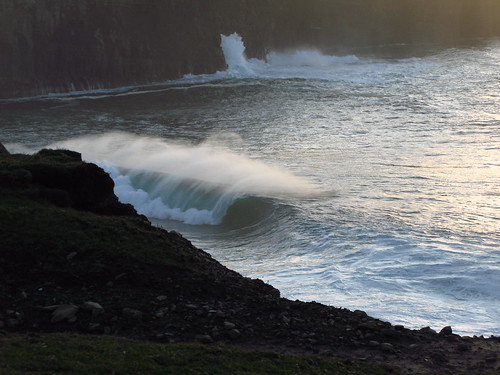So I thought i'd write a little entry detailing the different types of waves there are..
(a) Beach break - The most common break of all, if you're surfing in the UK or Europe then there's a good chance that you're surfing a beach break. These waves break over a sandy seabed, and often have a highly variable topography (underwater depth)
 Examples, the rolling waves of my local break, Cayton bay, or the gaping barrels of the famous beach break, Hossegor in France.
Examples, the rolling waves of my local break, Cayton bay, or the gaping barrels of the famous beach break, Hossegor in France.Depending on the depth of the water, beach breaks may open up opportunities for a few good barrels, only if you've found a good surf spot though!
(b) Point breaks - Some of the most sought after breaks of all, good point breaks are few and far between, a single waves from a nice point break should keep a surfer hyped for weeks, as is the length of the rides.
Point breaks are created when swell comes into contact with a jutting rocky or sandy headland, wrapping around it to form long rippable walls.
Examples of famous point breaks are Chicama in northern Peru, said to be one of the longest waves on Earth, and Bells Beach in Australia
(c) Reef breaks are hailed as the holy grail waves of surfing, unlike beach breaks which are prone to change due to shifting sand banks, reef breaks never change and so offer a perfect, almost mechanical wave.
Reef breaks, as their name suggests, break over a reef. The reef could be made of anything, rock, coral, even manmade. Some of the best reefs while providing flawless barrels, can be very dangerous, some with only a few inches of water covering the reef its self.
Some of the heavier and shallower reef breaks have got the name 'slab' due to the thick, mutant nature of them. Slabs are prized by bodyboarders and daring surfers as some of the most exhilirating rides possible.
Locations of slabs and reef breaks are often kept a secret as to stop them becoming too busy, however slabs may be found all over the world in the most unexpected of places!
Photos, Ireland and Tasmania.
There are other types of waves, but i wanted to keep this reasonably brief, hope it was a worthwhile read!





That slabs picture is amazing man, Looks like a face in the wave. very nice, sucks to be land locked here.
ReplyDeleteNice one, I can pretend to know what my mate is going on about now.
ReplyDelete